
The Langtang Valley trek is relatively short but one that runs through rhododendron and bamboo forests, Along with a tranquil nature, unique culture and tradition of Tamang and Sherpa ethnicities, Langtang Valley Trek offers you a majestic view of Mt. Langtang Lirung (7227m). The trail gives you the pleasure of experiencing the natural diversity, wildlife, and some of the famous Buddhist monasteries. Furthermore, trekking along the ancient villages, long terraces, sloppy landscapes, and beautiful forest of pine and rhododendron is certainly bound to make your adventurous journey a pleasant memory for a lifetime.
However, the Langtang Valley is almost devoid of visitors these days as the people of Langtang are continuing to rebuild their lives after the 2015 earthquake. Survivors of the landslides caused by the earthquake were forced to leave the valley, but now they have come back to reclaim their homeland, rebuild their homes and re-establish their farms.
Trekking in this beautiful valley will support the people of Langtang by providing much-needed income to rebuild in a sustainable and secure way. This is not charity; this is the business end of sustainable travel, where your travel choices can respectfully support local people while preserving their dignity, their culture and their way of life. Be wowed by nature, be humbled by the human spirit and be a part of local solutions when you choose to trek in Langtang.
Corporate Adventure Treks has been operating treks around Nepal and in the Langtang region for a number of years. The transportation and accommodation services along the trip will be one of the finest. We also have trek guides who speak the local language and have an intimate relationship with the region and local people.
As always for any modification of the Langtang Trek, extend, or any other Trek or Tour in Nepal please contact our specialist [WhatsApp: +9779851029803 Saroj] Team during your booking or via the quick inquiry.
| Activity | Distance (km) | Duration (hours) | Altitude (m) |
|---|
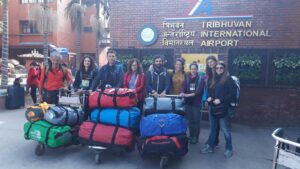
Your arrival in the beautiful country of Nepal is marked with a warm welcome by a Corporate Adventure representative. Shortly after, you will be transferred to your hotel. Overnight stay at a hotel in Kathmandu.
From Kathmandu, you’ll start your journey towards Syabrubesi. It is a long drive of 7 to 8 hours through the northwestern hills of Kathmandu. Along the way, you’ll witness a stunning view of Ganesh Himal (7422m), Manaslu(8163m), and many other peaks. Driving past TrishuliBazaar and enjoying the lifestyle and culture of old villages leads you towards Dhunche. Finally, you’ll reach Syabrubesi. Overnight stay at Syabrubesi.
Meals: Breakfast [1], Lunch [1], Dinner [1] , Transport [ By jeep], Accommodation [ 1 night]
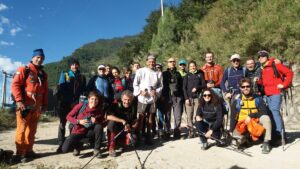
Today is the first day of our adventurous trekking. Along with BhoteKoshi River and Langtang Khola flowing on the edge, you’ll ascend towards the dense forest of pine, oaks, rhododendron, and bamboo. While reaching the settlement of Rimche, you’ll cross numerous suspension bridges and waterfalls. Witnessing some endangered wildlife such as wild boar, red panda, and Langur monkey and walking along with evergreen beauty of nature is a pleasant feeling in itself. Overnight stay at Lama Hotel.
Meals: Breakfast [1], Lunch [1], Dinner [1] , Accommodation [ Tea house 1 night]
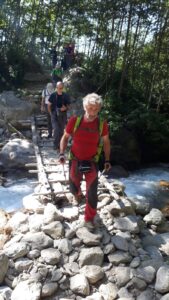
The trail continues to climb through forest, with occasional glimpses of Langtang Lirung between the trees. At Ghoda Tabela (3,000 m. / 9,842 ft) the trail emerges from the forest and the mountains loom on either side of the valley. Once there was a Tibetan resettlement project here, but now it is a Nepal Army post with no permanent inhabitants. The trail continues to climb gently and the valley widens, passing a few temporary settlements used by herders who bring their livestock to graze in the high pastures during the summer. You will probably glimpse your first yak if you haven’t already.
The next part of the trail is a somber reminder of the 2015 earthquake. Where Langtang village once was, with numerous lodges, there is now only a huge rock field. Spare a thought for the Nepalis and tourists who lost their lives here, and remember that your journey here will help support the survivors.
Mundu is just half an hour’s walk further on. The old houses here are a reminder of what all the villages once looked like in this valley. Most of the lodges and homes in this area are now built in a more modern style.
Meals: Breakfast [1], Lunch [1], Dinner [1] , Accommodation [ Tea house 1 night]
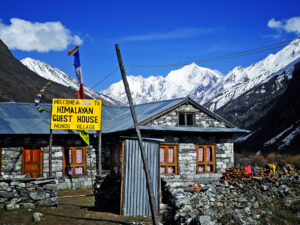
After breakfast, you’ll start your trek towards Kyangjin Gompa. The trail climbs gradually through yak pastures as the valley opens out further and the views become more extensive. After crossing several small streams and moraines, the trail reaches the settlement at Kyangjin. Here there is a small monastery and a government-operated cheese factory, which is a good place to stock up for lunch and afternoon snacks.
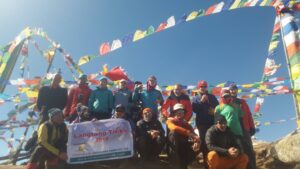
As you will arrive by lunchtime there is time to take it easy in the afternoon or explore the area. If you are feeling energetic, head up the Valley towards Langshisha Kharka to see some of the amazing views.
Meals: Breakfast [1], Lunch [1], Dinner [1] , Accommodation [ Tea house 1 night]
Today is the acclimatization day. After breakfast, you can visit the monasteries and even take a short walk to see the moraines and glaciers of Mt. Langtang Lirung(7227m). During daytime, you’ll ascend slowly upward to the summit of Tserko Ri(4984m), which is the highest point of this trek. It offers the 360-degree view of Langtang Valley. Roaming around the local market and observing the unique culture and tradition of the people living in this area would also be an ideal choice. Overnight stay at Kyanjin Gompa.
Meals: Breakfast [1], Lunch [1], Dinner [1] , Accommodation [ Tea house 1 night]
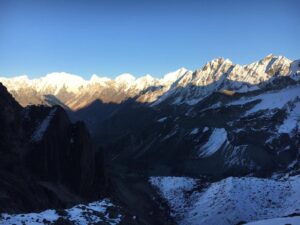
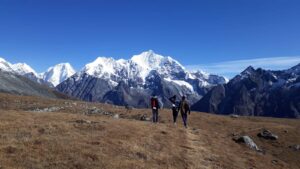
While trekking back to Lama Hotel from Kyanjin, the trail passes through Mundu and proceeds to the settlement of Ghodatabela. On the way down, you’ll cross several wooden bridges and get the sublime view of snow-capped mountains following the Langtang Khola. You’ll finally reach Lama Hotel crossing Gumanechok. It along seven to eight hours trek along with the wilderness of wide forest of rhododendron and pine and natural floraand fauna. Overnight stay at Lama Hotel.
Meals: Breakfast [1], Lunch [1], Dinner [1] , Accommodation [ Tea house 1 night]
This is the final day of trekking. You roll on the path you took on your way up early and pass through the dense forests to reach Sybrubensi. You bid farewell to the Langtang Mountains and gradually descend to Sybrubensi. After reaching, Sybrubensi you can celebrate the completion of the trek with the group members. Overnight stay at Sybrubensi.
Meals: Breakfast [1], Lunch [1], Dinner [1] , Accommodation [ Tea house 1 night]
The trip comes to an end today. You have two options after reaching Trishuli Bazaar. You can either travel via Kakani or follow Trishuli River via Galchi. A private bus will come to pick you up at Sybrubensi and take you back to Kathmandu. In Kathmandu, you can head to the markets to shop for gifts and souvenirs. Overnight stay at a hotel in Kathmandu.
A Corporate Adventure member will assist you to the airport for your scheduled flight to your destination. We hope you had a great time with us. Or Have time choose next ant destination like safari trip to Chitwan, City trip to Pokhara etc…
The general standard of driving throughout Nepal is poor and badly regulated. Roads in Kathmandu are very congested, many drivers are not properly licensed and vehicles are poorly maintained. During the monsoon season (June to September) many roads outside the Kathmandu valley are prone to landslides and may become impassable.
Trekking to the Langtang National Park, you have to first drive to Syabrubesi, Dunche, or Bharkhu to start the trek. Public buses are available from machhapokhari/ Balaju buspark; Kathmandu, but slow. A private vehicle or jeep is a much better option. Exit is via the same route unless you trek over Gosainkunda and back through Helambu trek to Kathmandu.
We will be accommodated in 3 star standard hotel in Kathmandu and teahouses during the trek. The Langtang Valley had been very well set-up with plenty of comfortable lodges. While the earthquake and landslide destroyed many in certain towns (most dramatically, in Langtang Village), plenty of other settlements were less affected and good options are still plentiful. The standard here is good, with warm blankets, fireplaces, comfortable beds, the occasional hot shower (for an extra fee)
All accommodations are on twin-shared basis. Single supplement will be served on request and will cost an additional USD 270. Corporate Adventure treks rooms with attached washrooms; however, teahouses in some places only have shared washing and toilet facilities. Also note that single rooms are readily available in Kathmandu and the trekking regions at lower elevation but it might be difficult to find them at higher elevations.
During our trek, we can enjoy authentic Nepalese food as well the more common international cuisine (Tibetan, Continental, Italian, Indian, etc.). Breakfast and dinner will be served from the teahouse or from a lodge menu where we spend the night whereas lunch will be served on the way to the next destination. All meals will be provided during trekking while only breakfast will be available in Kathmandu. There will also be welcome and farewell dinners for guests.
You’ll need a TIMS card (US$10 or equavalent Rs 1000) and a Langtang National Park permit (US $30 equavalent Rs3000). If you’re trekking with an agency, they will arrange these for you. If you’re arranging the trek yourself, you’ll need to pick up your TIMS permit in Kathmandu and your Langtang National Park permit in Dunche
For this trek there will be one leader, assistant leader (10 trekkers: 1 assistant guide) and Sherpa porters for carrying luggage (2 trekkers: 1 porter). This arrangement ensures that should anybody in the group get sick, the trip can still go ahead as planned. We can run the trek for groups of any size but we after years of experience we have found a maximum of twenty people to be the optimum size for a successful trip. However, if you’d like to book this trip for a larger group then that can be arranged too.
Remember you will be trekking to the Kyangjin gompa/ Kyangjin Ri (4,850 m. / 15,912 ft.).
To let your body get used to the thin air, you need to walk slowly, steadily, and keep your body hydrated. If you try to hasten and walk fast to reach your destination in less time, chances are you may suffer from AMS or Acute Mountain Sickness.
AMS symptoms like dizziness, headache, nausea, shortness of breath, fatigue, etc., are seen at elevations above 2000 meters. Usually, these symptoms occur once you reach Namche or beyond Namche.
Taking Diamox and a good night’s rest may work for mild cases. Drinking plenty of fluids (water, tea, soup, etc.) and keeping your body hydrated will also help to keep the sickness at bay. One should take the necessary precautions to ensure that the condition does not worsen. But if the symptoms worsen, one may have to return to a lower elevation and get medical help.
It is important to keep your body hydrated on the trail as dehydration also causes AMS. One should drink at least 3-4 liters of fluids daily.
We dissuade you from buying bottled water as it adds up to the thrashing problem in the mountains. Moreover like everything else, bottled water is also expensive in the mountains.
We highly recommend you to carry a reusable water bottle with you, one that can hold hot water. You can use one with a steri pen or an inbuilt filtration system like LifeStraw. You can also use water purification tablets to treat the water. While the water in the mountains tends to be pure and without impurities, it’s better not to take chances and filter or treat the water before drinking.
Using chlorine or iodine tablets to treat the water may alter its taste. You can add flavored electrolyte powder (which readily available at pharmacies in Kathmandu) to mask the bitter chemical taste. Adding electrolyte to your drinking water may also be beneficial as the minerals (sodium, potassium, magnesium, etc.) you lose while walking gets replenished.
Teahouses offer boiled drinking water at an additional cost. It can cost anywhere between 1 USD to 4 USD. The price increases gradually as you climb higher. While cold water is provided free of charge, it is not advisable to drink untreated tap water.
| Start Date | End Date | Total Person | Price From |
|---|